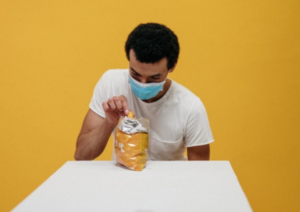 Oh how we all love to eat! And going out to our favorite restaurants makes it all the more fun, but now we have COVID and this is one situation that we cannot turn our heads and pretend that it is not there.
Oh how we all love to eat! And going out to our favorite restaurants makes it all the more fun, but now we have COVID and this is one situation that we cannot turn our heads and pretend that it is not there.
This omnipresent virus has turned the world upside down and by the looks of it, things are not going to change anytime soon. The rapid spread of the coronavirus continues to steadily infect people in nations worldwide. But between the intractable virus and healthcare professionals struggling to concoct an antidote, the public is desperately looking for some solace.
And what better way to gain some well-deserved comfort than gorging on delicious food? Owing to the widespread uncertainty and suffocating restrictions due to the pandemic, people are running out of patience and doing things they shouldn’t be, such as dining out any chance they get.
Eating at Bars and Restaurants: A Big No-No
Who knew that the seemingly unimportant saliva would become such a threat to the simple pleasure of eating out? But sadly, that’s what the world has come to because now the dribble that is ever ready to drizzle down at first sight of appetizing food can take lives.
And whether you like it or not, restaurants and bars are its main attacking arenas, which is why dining out is extremely dangerous these days.
A study conducted in September revealed that people who tested positive for the coronavirus are twice more likely to have eaten at a restaurant than those who tested negative. This means that no matter how quickly you devour a chocolate pie at a swanky café or gobble down the ever-popular succulent hamburger at your favorite fast food joint, you are equally at risk of contracting the novel coronavirus.
Mask or No Mask: The Threat Remains
 The unfortunate circumstance about eating is that it requires you to open your mouth, which means you will be exposed to respiratory drops one way or another.
The unfortunate circumstance about eating is that it requires you to open your mouth, which means you will be exposed to respiratory drops one way or another.
So even if you are one of those honorable people who always abide by COVID policy, you will have to compromise on your principles and go against the mandated restrictions when having a meal. Unless you find a way to consume food without removing your facemask, you will increase the odds of acquiring the virus, as well as endangering others by eating outside of your home.
According to the Center for Disease Control, eating at restaurants is a chief risk factor in spreading the SARS-Cov-2. Just thirty minutes of exposure to someone carrying the virus can leave you infected. Moreover, sharing dips and dishes is also a veritable source of COVID-19 transmission. You never know if a sauce you are sharing with someone carries droplets from an infected person’s mouth, which can, in turn, give you the infection.
And since not all COVID patients exhibit symptoms, someone can transmit the virus without ever knowing that they had the disease in the first place (asymptomatic). Simply put, there is no way you can dodge the coronavirus bullet at an indoor eating place.
Can You Wheedle Your Way Into the Dining Out Fun?
The coronavirus pandemic has been going on for quite a while now, prompting restaurant and bar owners to shut down business every few weeks during the past year to control the disease’s transmission. But without an end in sight, bistro owners are forced to look into ways to keep the business up and running despite the health threat. And that is why many restaurateurs are employing creative techniques to stay afloat.
Long story short, you might be able to enjoy dining out after all, but not without a slew of restrictions.
Taking Inspiration from the Italians

Just as Italy was beginning to recover from the coronavirus’s first wave, a second tide washed over the country. Businesses were only starting to open up again, but as the biting winter winds rolled around, people began falling sick again.
A second wave of the pandemic meant lockdowns in cities and restrictions on social gatherings. In the wake of which, restaurant owners had to find a way to keep their diners in business without taking any drastic measures such as doubling their prices. And that is what the owners of VagInUfezzi Bologna did.
To survive the resurgence of the coronavirus, Antonella De Sanctis and her husband, MircoCarati decided to follow the post-war Bolognese osterie, a tempo’s lead to save VagInUfezzi Bologna from a loss. Now, the diners are coming to satiate their hunger by paying by the hour instead of the dishes being served. So the less time someone spends inside the restaurant, the less they pay.
A table at VagInUfezzi Bologna costs $21.00 per person for one hour and $31.44 for two hours, excluding wine, liqueurs and coffee. And adhering to the social distancing rules, the restaurant has gone from catering to 25-30 people at a time to just 10-15.
Antonella and Micro didn’t want to suddenly shoot up the prices of their dishes because they thought that would be unfair on the eaters. Hence, they chose to charge people by the hour; this way, visitors get to enjoy the experience of dining out while minimizing the risk of COVID transmission.
In order to pay as little as possible, diners eat quickly and vacate the tables, which in turn reduces the duration of exposure. In short, the less time spent at the bistro equals less cost and minimal chances of contracting the coronavirus.
However, putting a time constraint on diners eating out doesn’t completely eliminate the possibility of catching the virus, but that seems to be the only viable option to save eatery businesses.
Is There Light at the End of the Tunnel?
According to the guidelines published by the CDC, it’s safer to stick to pick-ups, drive-throughs and delivery services to satisfy your taste buds during the pandemic. And if you still choose to go to a restaurant to eat, be sure you wear a mask at all times, maintain a six-foot distance from fellow diners and not touch anything unnecessarily. You should also keep a bottle of hand sanitizer on you and avoid sharing dips, sauces, or any food.
Additionally, the vaccine is coming and will be here hopefully by the end of the year, but until then, follow all COVID policies and work out a plan for eating out so you can minimize getting infected while also helping to keep restaurants financially alive.
